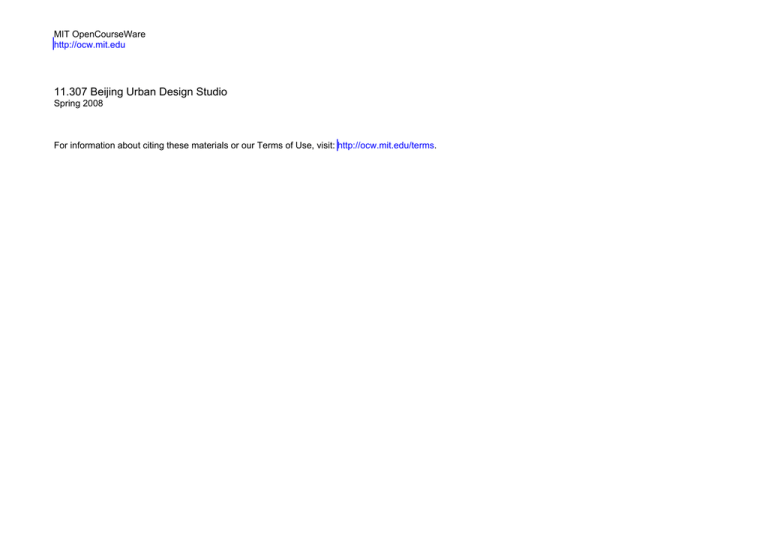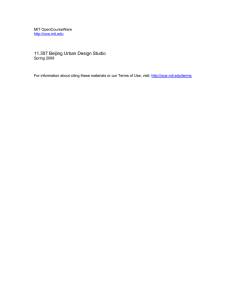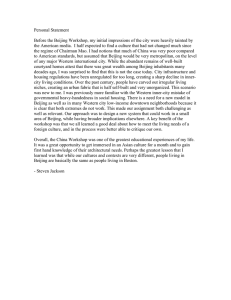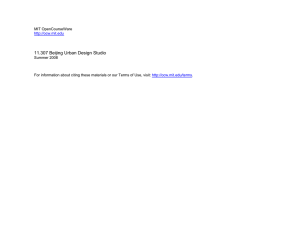11.307 Beijing Urban Design Studio MIT OpenCourseWare Spring 2008 rms of Use, visit:
advertisement

MIT OpenCourseWare http://ocw.mit.edu 11.307 Beijing Urban Design Studio Spring 2008 For information about citing these materials or our Terms of Use, visit: http://ocw.mit.edu/terms. Th he Site Solvent 150’ Oil Sand Categgories of Contaminants • Solvents e.g.: Paint th hinner, and d parts degreaser. Sources: Garages, industry. • Heavy metals e g : Lead e.g.: Lead, Arsenic, Arsenic Chromium, Chromium Cadmium, Cadmium and Mercury. Mercury Sources: Metal finishing, metal plating, and manufacturing. • Petroleum e.gg.: Gasoline,, diesel,, and motor oil. Sources: Underground storage tanks, gas stations, tank farms, pipelines. Cleanup Methods for Brownfields • Remove the hazardous substances and store them at a safer location. • Leave the substances where they are, but control them –Caps and Slurry Walls –Solvent Extraction –Bioremediation Cleanup and Land Use • The type of use determines the type of p. cleanup • Residential use demand the highest level of cleanup because this land use involves the cleanup, the greatest likelihood of exposure. Contamination Assessment of the Shougang Site • Proxy—previous production activities on the site – Manufacturing plant, esp. refractories plant – Waste water disposal –Railway transport –Cokemaking plant –Raw material/Slagg storagge Beijing Studio 2008 Information on transformation of Beijing City and past Beijing Studios Dennis Frenchman, Jan Wampler, Chris Zegras, Daphne Gondhalekar, Yang Jiang 20 Methodology: Analysis matrix BEIJING STUDIOS . STUDIO DATE AND SITE 1985 Shishahai, Dianmen Street 1987 Dashala, Pipe Street, Royal Academy 1992 Dewai Street, Longfusi Market, Fragrant Hills 1995 White Rice Street 1998 White Pagoda 2000 Two Bridges 2002 XiYuan 2004 Railway corridor 2006 Sun Palace 2008 Capital Steel Plant ¾ BEIJING CITY CONTEXT QUALITATIVE DATA About the studio site • Condition of site at time of studio • Studio ideas at the time of the studio • Current condition of site Relation with the studio • Government • Academic • Residents • Developer Other • Similarity between studio proposals and actual outcome • Analysis theme • Site story • Larger Beijing story Demography Economy Policy • Land-use • Housing / built environment • Transportation • Energy • Green space / environment QUANTITATIVE DATA Infrastructure • Transport • Infrastructure • Energy Land Use • Housing • Commercial • Industry Urban planning system Historic events Analysis of relationship between studio and real city transformation to assess the performance of the studios: How did the context of the real city y information influence the studios? How did the studios impact the real city? 21 Huge urban expansion on limited land resources Population density distribution Beijing urban expansion N 60,000 50,000 Beiji ijing densestt streets Persons/km2 40,000 City proper 30,000 1983 N 20,000 10,000 Suburbs and rural area 2005 2003 2001 1999 1997 1995 1993 1991 1989 1987 1982 1980 - 2000 Source: Beijing Statistical Yearbook ¾ ¾ ¾ Figures by MIT OpenCourseWare. Urban population has more than doubled since 1978 40% of city population expected to move to outer suburbs by 2010 Urban development pattern becoming increasingly dispersed 22 Comparative population densities in 2000 Courtesy of Alain Bertaud. Used with permission. 23 Increasing residential consumption 3,000 Total 2 500 2,500 High-storied Hi h t i d (10 stories t i andd above) Mid and High-storied (7-9 stories) More-sttoried i d (4-6 (4 6 stories) t i ) 10,000 sq.m m 2,000 1,500 Traditional inner city housing Low-storied (1-3 stories) 1 000 1,000 High-rise construction in the urban fringe 500 0 1997 1998 1999 2000 2001 2002 2003 2004 Source: Beijing Statistical Yearbook ¾ ¾ ¾ Per capita GDP has increased 10‐fold since 1978 P capita Per it living li i space has h d doubled bl d since i 1986 New residential construction increasingly urban fringe high‐rise 24 Increasing residential energy consumption Energy consumption of households Increase in durable consumer goods Per 100 households annual possession of durable consumer goods off 2000 urban b h households h ld 10,000 kwh 10,000 kwh 180 Source: Beijing j g Statistical Yearbook 160 1,000,000 140 900 000 900,000 TOTAL consm by households 800,000 Rural Households 700,000 Urban Households 600,000 500,000 400,000 300,000 200,000 120 1986 1987 1988 1989 1990 1991 1992 1993 1994 1995 1996 1997 1998 1999 2000 2001 2002 2003 2004 2005 80 Air conditioning units widespread 60 40 20 Showers Washing machines Colour TV sets 2005 2004 2003 2002 2001 2000 1999 1998 1997 1996 1995 1994 1993 1992 1991 1990 1989 1988 1987 1986 1985 1980 1979 0 1978 Unitts 100,000 100 Refrigerators 25 Rising Car ownership with decreasing urban density Growth trend of vehicles, cars and motorcycles in Beijing Increasing car ownership and congestion in Beijing Number of vehicles (000s) 3000 2500 2000 Total vehicles Cars Motorcycles 1500 1000 500 0 1997 1998 1999 2000 2001 2002 2003 2004 2005 Years Figure by MIT OpenCourseWare. ¾ ¾ ¾ ¾ 1984: Residents entitled to own private cars 1995: Beijing Master plan (1991‐2010) proposes public transport mode shares 47 % by 2000 2000: Local families encouraged to own automobiles 2008: Car increase in Beijing: 1400 per day 26 Beijing design studio sites: studying d i changing h i urban b development d l pattern Example of dense traditional urban area: 27 1985: Inner city urban renewal: Shishahai area STUDENT PROPOSALS: ¾ Preserve and densify existing housing ¾ Traffic congestion, pedestrian precinct along lake ¾ Selective intervention to accommodate economic growth Actual change: increasing congestion 28 1985: Urban fringe issues: Haidian Town Haidian in 1985 Student proposals STUDENT PROPOSALS: ¾ Maintenance of continuity and quality of life ¾ Develop commercial area ¾ Enable pedestrian precincts Actual change: demolition of original town 29 1992: Large‐scale commercial development STUDENT PROPOSALS: ¾ Keep viable existing community and small scale market ¾ Develop site into important commercial centre Actual change: disappearance of original community 30 2004: Public transport‐oriented development STUDENT PROPOSALS: ¾ Both sides of rail to develop as a whole ¾ Densify land-use mixture ¾ Motor vehicle restriction Actual change: much larger in scale than anticipated 31 2006: Urban village: Sun Palace Neighborhood STUDENT PROPOSALS: ¾ Integrate existing structures, densify and add green space ¾ Link to nearby subway stop under construction ¾ High g rise buildings g at edges g of site Actual change: complete demolition of existing community 32 Urbanization patterns driving land‐use change involving several stakeholders stakeholders 1) Inner city urban renewal With government support: ¾Outcome strongly resembles studio proposals: Sanitized residential and preserved historic with small‐scale commercial activity for tourists By developer: ¾Local government sees more profit in commercial redevelopment and invited developers: Sites cleared for ‘renewal’ renewal development 2) Large‐scale commercial development ¾No connection with government or residents ¾Studios anticipated less large‐scale commercial development 3) Transport oriented development ¾Studio discourse with local residents ¾In large government projects, old areas demolished ¾Scale of new development and clearance of all old areas not anticipated 4) Urban villages in greenbelt ¾Municipal government plans to implement greenbelt ¾But village collective invites developer to initiate large‐scale housing development for economic p profit ¾Studio had no contact with government or residents ¾Sites completely demolished 33




